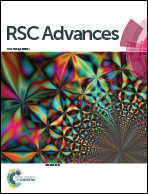Label-free nanoprobe for antibody detection through an antibody catalysed water oxidation pathway†
Abstract
We developed a nanoprobe for the label-free detection of antibodies associated with infectious diseases, through a method based on the antibody catalyzed water oxidation pathway (ACWOP). First, methoxy poly(ethylene glycol) (mPEG)–chlorin e6 was chemically conjugated to mPEG and chlorin e6 by esterification, to enable both singlet oxygen generation and loading of coumarin boronate. Subsequently, the nanoprecipitation method was used for spontaneous nanoprobe self-assembly from coumarin boronate and mPEG–chlorin e6, which resulted in a mean nanoprobe size of ∼200 nm. The potential of the nanoprobe as an antibody detection agent was evaluated by using human immunoglobulin antibodies as a model antibody. We confirmed that the nanoprobe generated singlet oxygen (1O2) via the photodynamic chemical effect of the chlorin e6 in mPEG–chlorin e6 and that water (H2O) was subsequently oxidized to hydrogen peroxide (H2O2) in the presence of the singlet oxygen through the ACWOP. The generated H2O2 was detected via the fluorescence of coumarin boronate in the nanoprobe. Specifically, the fluorescence intensity increased linearly with increasing antibody amounts, thus demonstrating the potential of the system as an alternative method for label-free antibody detection.


 Please wait while we load your content...
Please wait while we load your content...